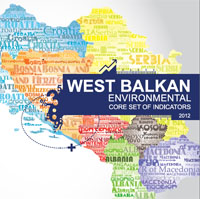| FREIGHT TRANSPORT DEMAND |
The indicator “freight transport demand” will be presented in two different ways:
1) To measure decoupling of freight transport demand from economic growth, the volume of freight transport relative to GDP will be used. The decoupling indicator is defined as the ratio between tkm (inland transport) and GDP (Gross Domestic Product in constant 2000 EUR). Presentation of this indicator in the Republic of Macedonia will be based on the baseline year 2000=100.
2) Modal split share of freight transport: This indicator is defined as the percentage share of each mode of freight transport in total inland transport. The unit used is tonne-kilometre (tkm), which represents movement of one tonne of goods over a distance of one kilometre. It includes road and railroad inland transport. Railroad transport is based on movements on national territory, regardless of the nationality of the vehicle. Road freight transport is based on all movements of vehicles registered in the reporting country.
The unit used is the tonne-kilometre (tkm), which represents the movement of one tonne of goods over a distance of one kilometre. It includes transport by road and rail.
Freight transport demand and GDP are shown as an index (2000=100).
Is the freight transport in road transport reduced compared to other transport modes?
Is the freight transport demand decoupled from economic growth?
The overall freight transport demand noted variable trend of increase and decrease during the analyzed period. The overall freight transport demand in 2016 increased by 53.9% compared to 1990 as a result of increase in road transport by 64.3%, while the railroad freight transport showed decline by 133% without positive impacts on environment.
Freight kilometers/GDP ratio in the period 2000 to 2016 followed the variable trend of the overall demand for freight transport.
Figure 1: Freight transport by modes in tone kilometers (in million km)
Figure 2: Share in percentages of tone kilometers of individual freight transport modes in the total freight transport
Figure 3: Total freight transport demand/GDP ratio
Data coverage: excel
Data source: State Statistical Office, http://www.stat.gov.mk/Default_en.aspx
The freight transport demand noted variable trend of increase and decrease during the analyzed period. Figure 2 shows that the highest share in freight transport belongs to road transport ranging between 59.6% (2000)and 96.9% (2016), while railroad freight transport had a share between 3.1% (2016) and 40.4 % (2000)of the total freight transport demand. The share of railroad in the total freight transport, after the positive trend in 2013 reaching 7.6%, noted decline in 2016 with a share of 3.1% or reduction by 59.2% which will increase the negative impact of transport on the environment.
The above is sufficient indication that the indicator should endeavour towards reduction of road transport in favour of other freight transport modes. The reason for this is that the road freight transport uses costly liquid fuels which during combustion on roads cause significant pollution of the environment, air, soil, biodiversity, etc.
Figure 3 shows that the trend of the index of the total freight transport demand relative to GDP had variable trend of increase and decrease, with domination of growing trend in the period from 2000 to 2006, after which there is a changing trend of increase and decrease by 2016. It is indexed on baseline year 2000=100 in order to monitor the changes in the intensity of freight transport demand relative to economic growth expressed through GDP
- Methodology for the indicator calculation
In order to measure the decoupling of freight transport demand from economic growth, the volume (i.e. intensity) of freight transport relative to GDP is calculated. Relative decoupling occurs when the freight transport demand rises at rate lower than the one of the GDP. Absolute decoupling occurs when the freight transport demand falls while GDP rises or remains constant.
The unit used is the tonne-kilometre (tkm), which represents movement of one tonne over a distance of one kilometre.
With regard to EU Member States, according to Regulation on road transport and Regulation (EC) No 91/2003 on railroad transport statistics, data is based on all movements of passenger transport on the national territory.
According to Regulation (EC) No 1172/98, data on freight road transport is based on all movements of vehicles registered in the reporting country. All other data on transport refer mainly to movements on national territory, regardless of the nationality of the vehicle.
- Sources of used methodology
Structural indicators of EUROSTAT on transport
State Statistical Office.
- Methodological uncertainty and data uncertainty
All data is based on movements on national territory, regardless of the nationality of the vehicle. Methodology of data collection has been harmonized at EU level. Sources include EUROSTAT, National statistical offices, ECMT, UNECE, UIC, DG TREN.
In order to answer the question whether the freight transport demand is decoupling from economic growth, the intensity of freight transport relative to changes in real GDP is considered.
Uncertainty of data sets
In order to obtain full picture of transport demand and corresponding problems in the environment, it would be very useful to supplement data with data on the number of vehicle-kilometers.
List of relevant policy documents
The National Strategy for Transport prepared and adopted by the Government of the Republic of Macedonia determines the main directions of the transport policy development in the Republic of Macedonia through identification of goals and development strategy for road, rail and air transport sectors.
Legal grounds
The road transport is regulated by the Law on Road Transport. It regulates the conditions and the manner of performing transport of passengers and goods in internal and international road transport.
Transportation of dangerous goods is regulated by the Law on Dangerous Goods Transportation in Road and Railroad Transport, regulating the conditions under which transport of dangerous goods shall be performed (preparation of matter, loading, transport, on road procedures, unloading, safety in transportation, vehicles equipment and staff training).
Railroad transportation is regulated by the Law on Railroads, Law on Agreements on Transportation in Railroad Traffic, Law on Agency Regulating Railroad Transport Services Market and Law on Railroad Transport Safety.
The fourth goal of the National Strategy for Transport is securing sustainable protection of the environment.
- EUROSTAT
| Code | Title of the indicator | Compliance with CSI/ЕЕА or other indicators | Classification by DPSIR | Тype | Linkage with area | Frequency of publication | |
| MK NI 036 | Freight transport demand | CSI 036 | Freight transport demand | P | B |
|
Monthly
Periodically Annualy |








































































